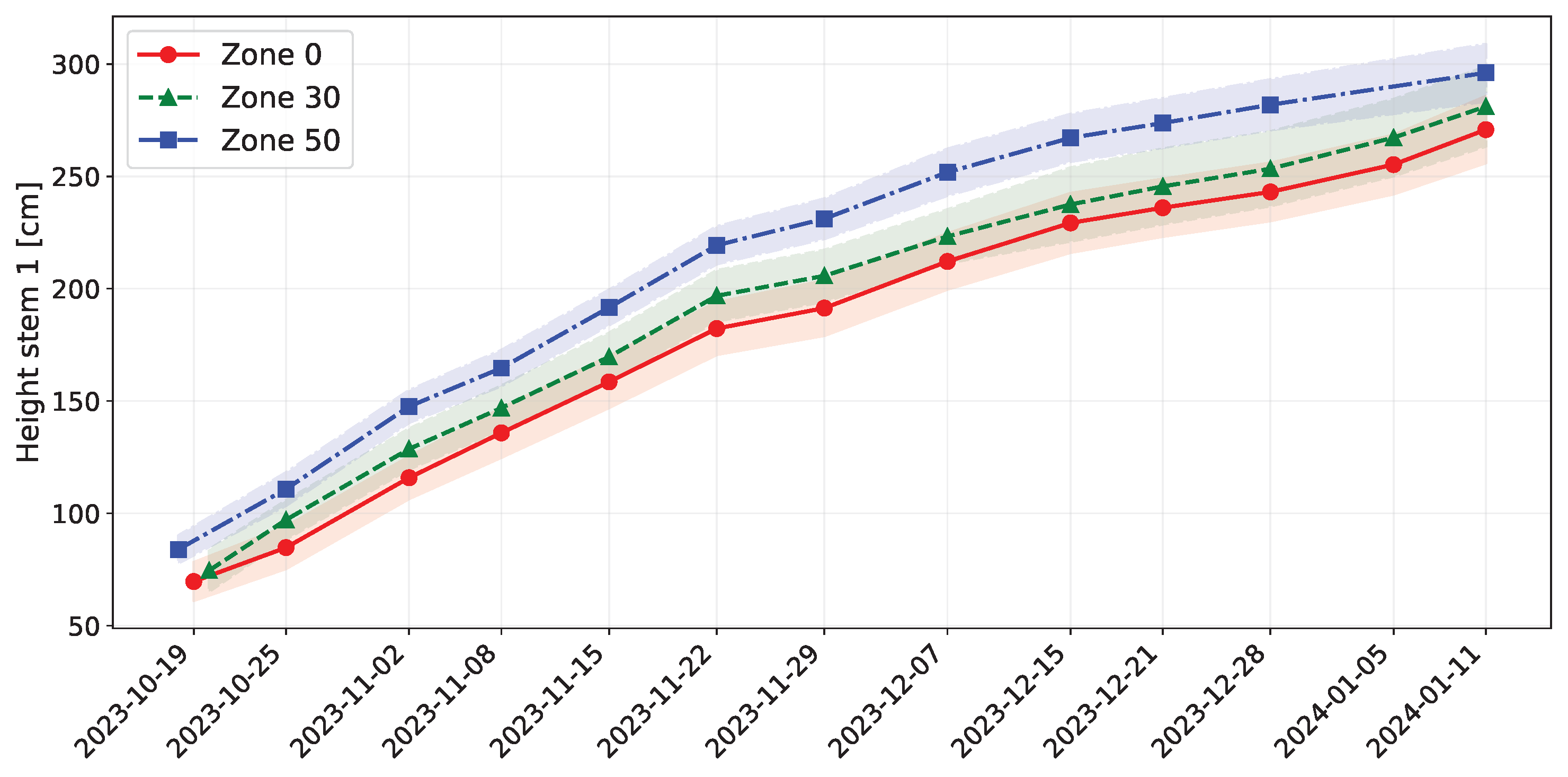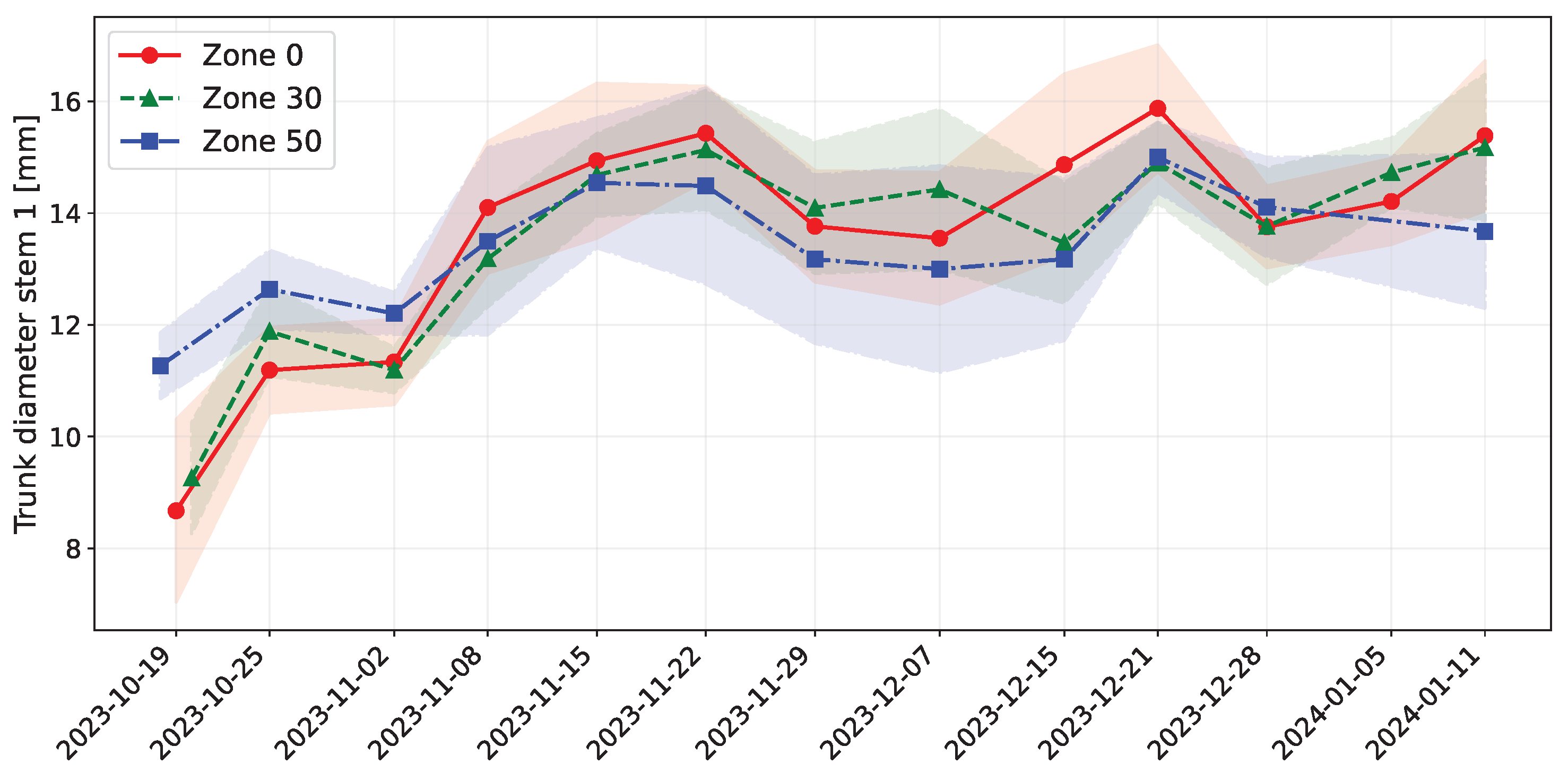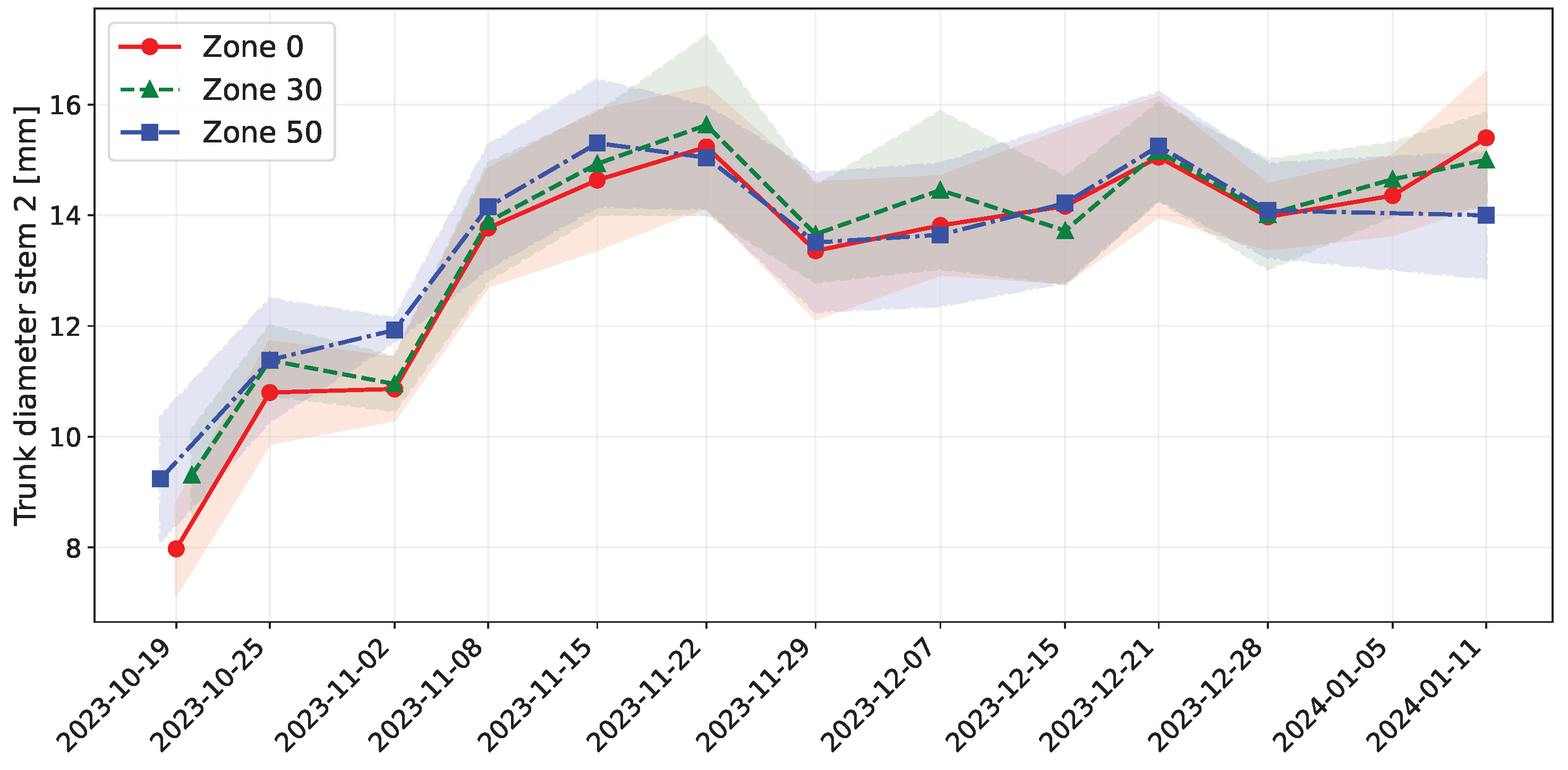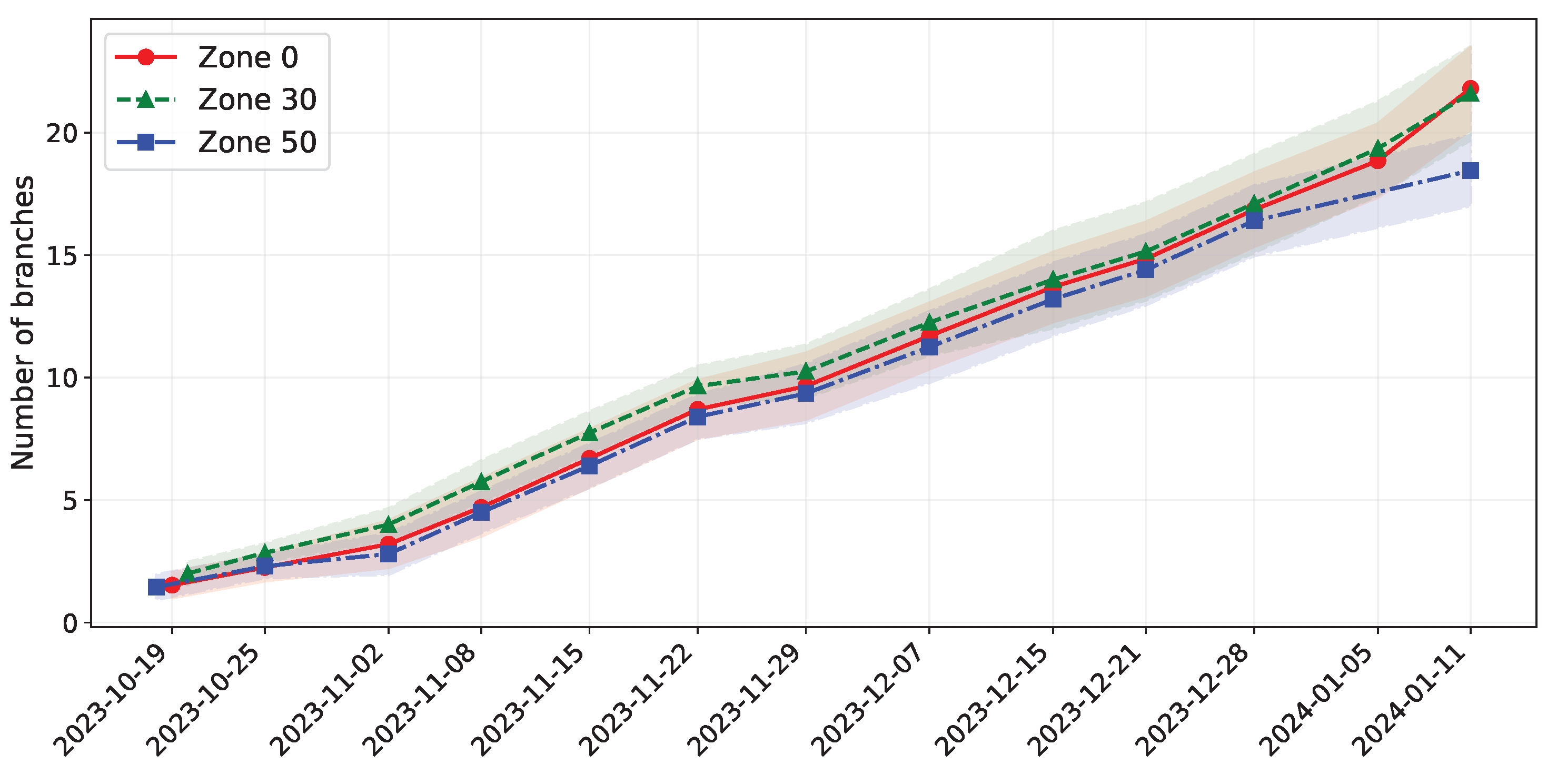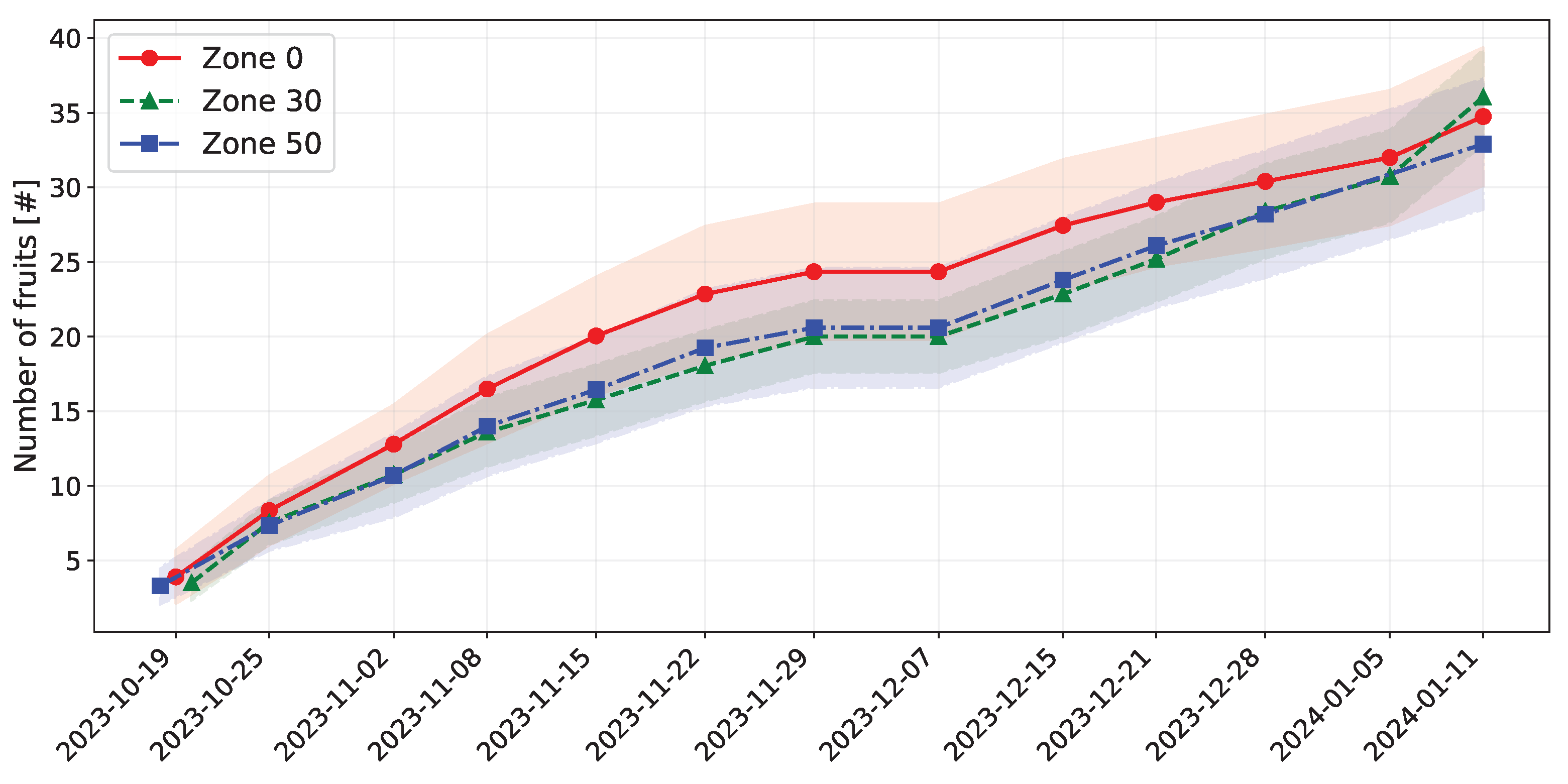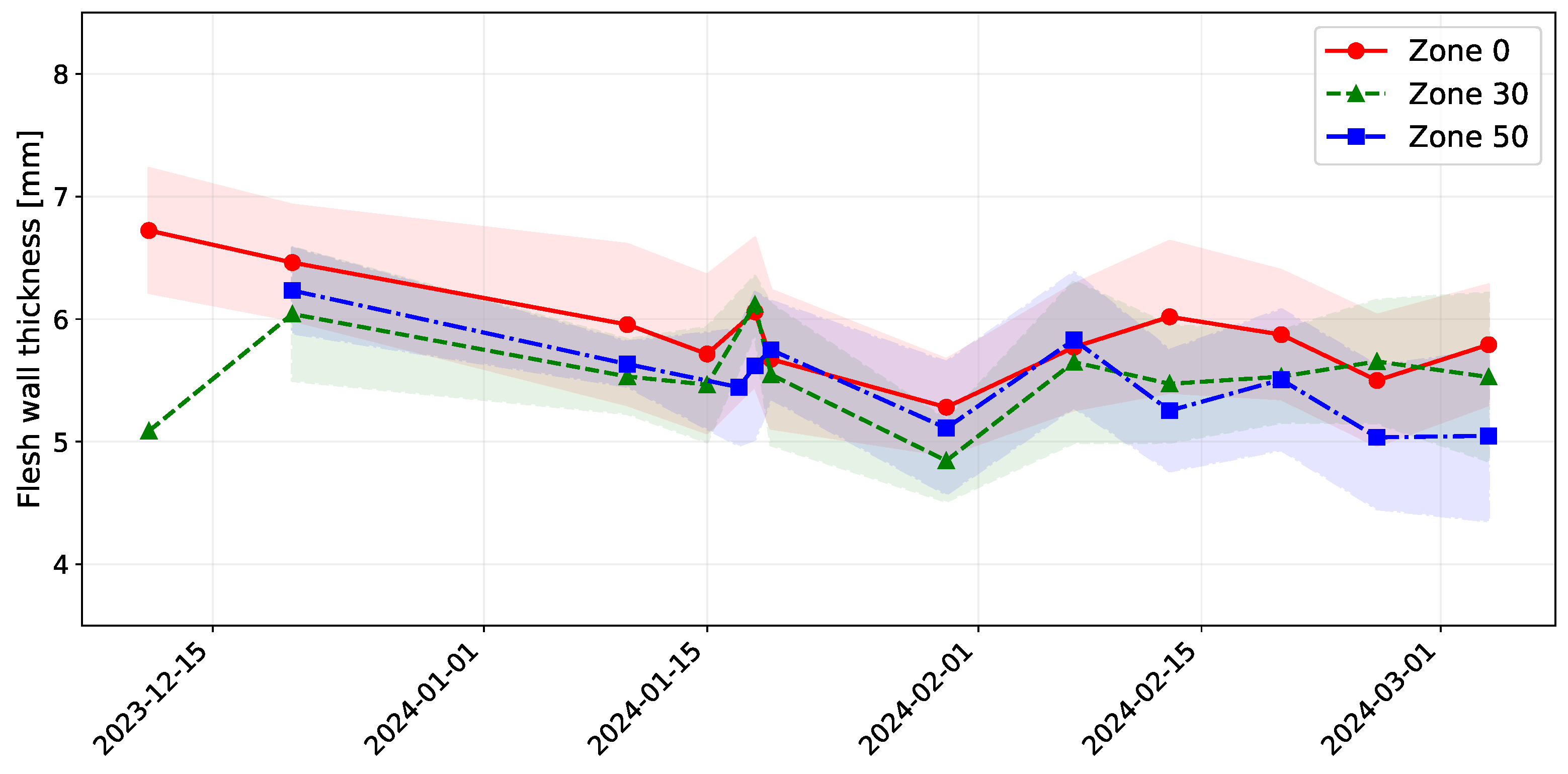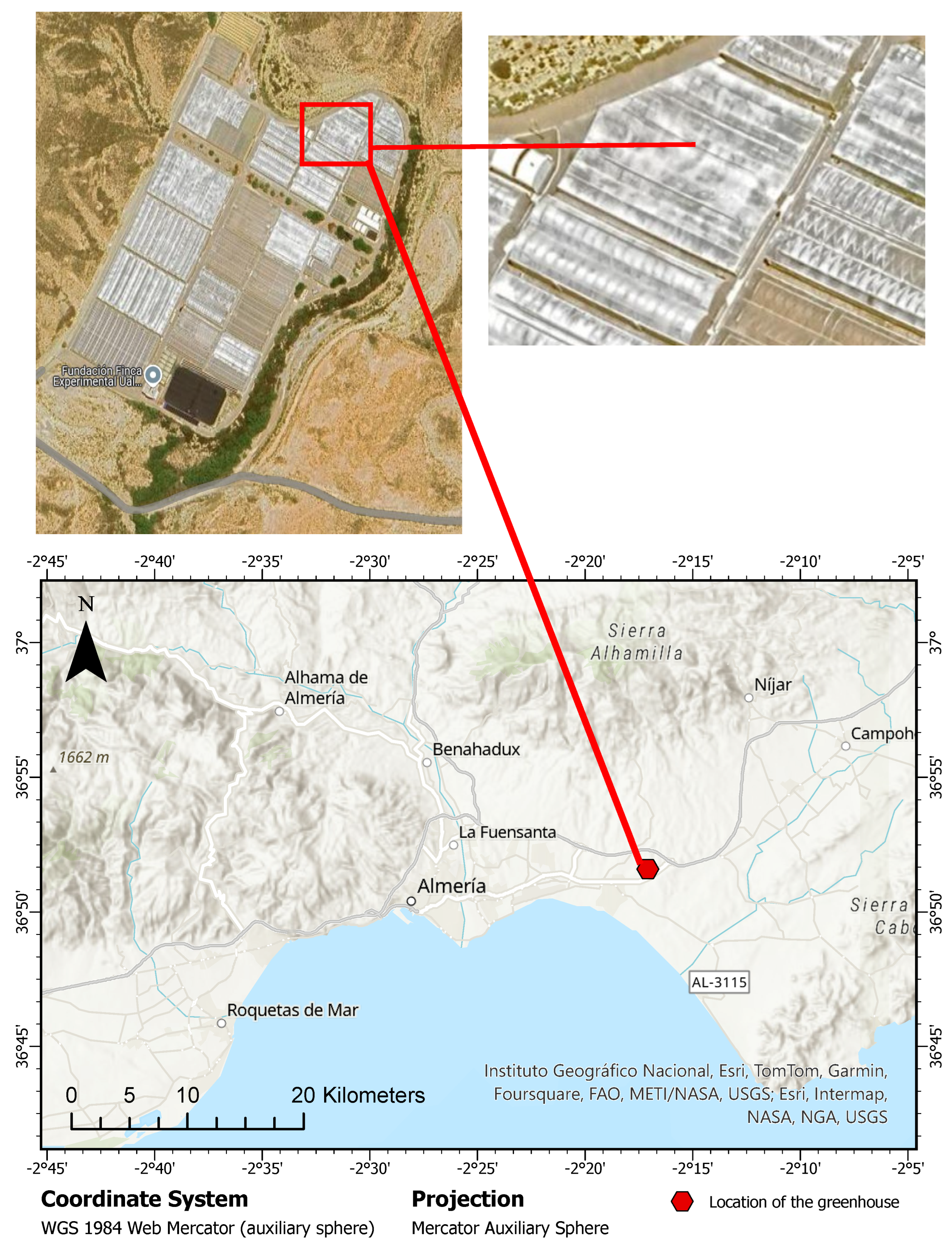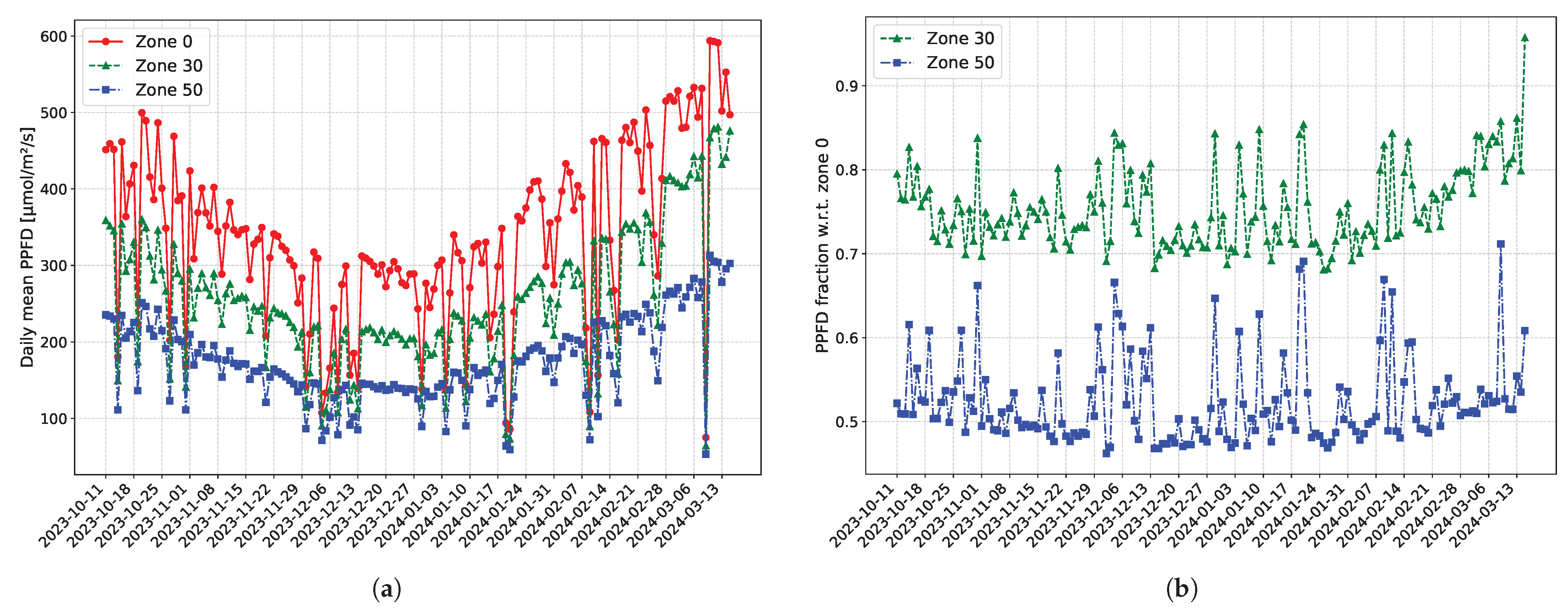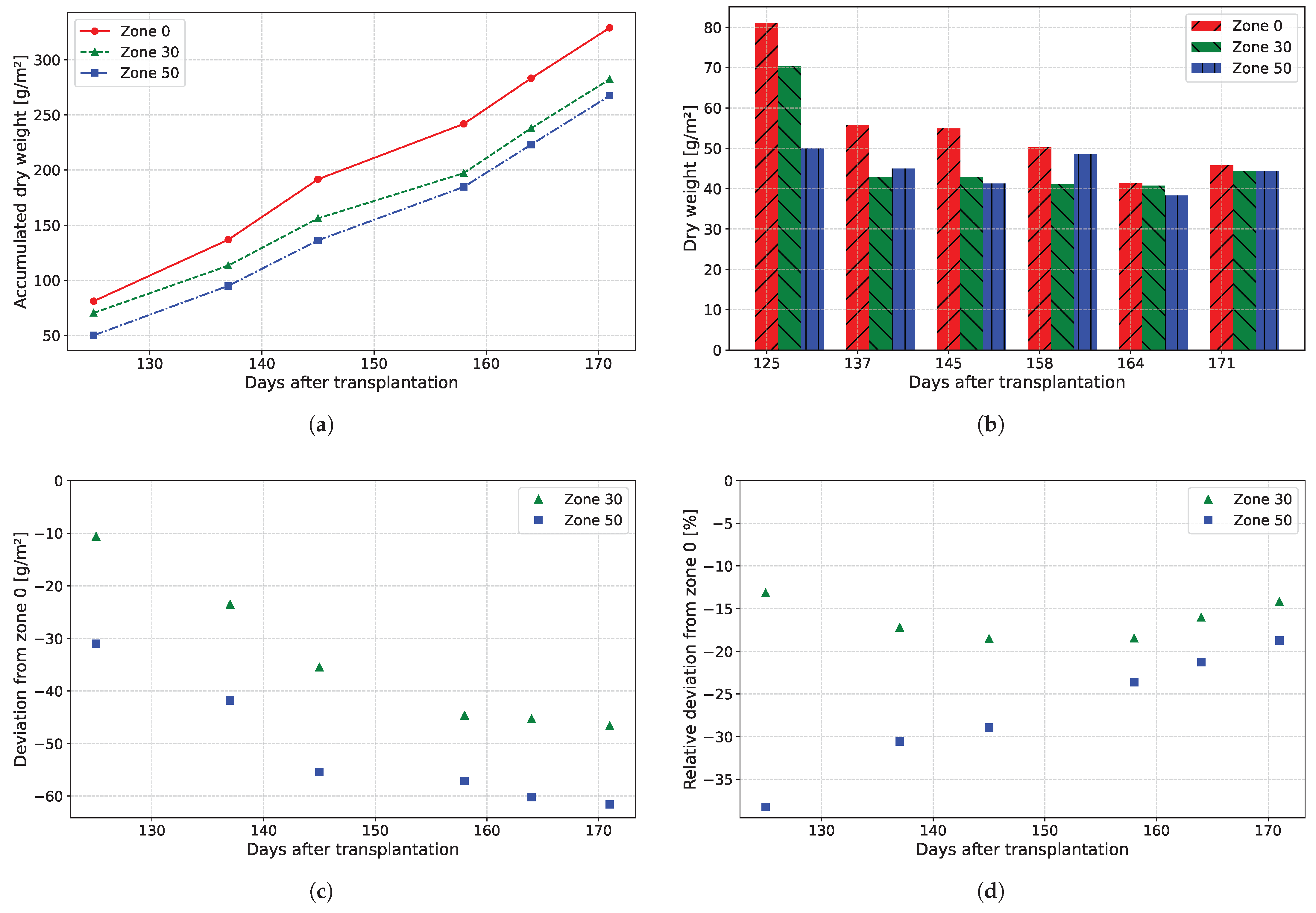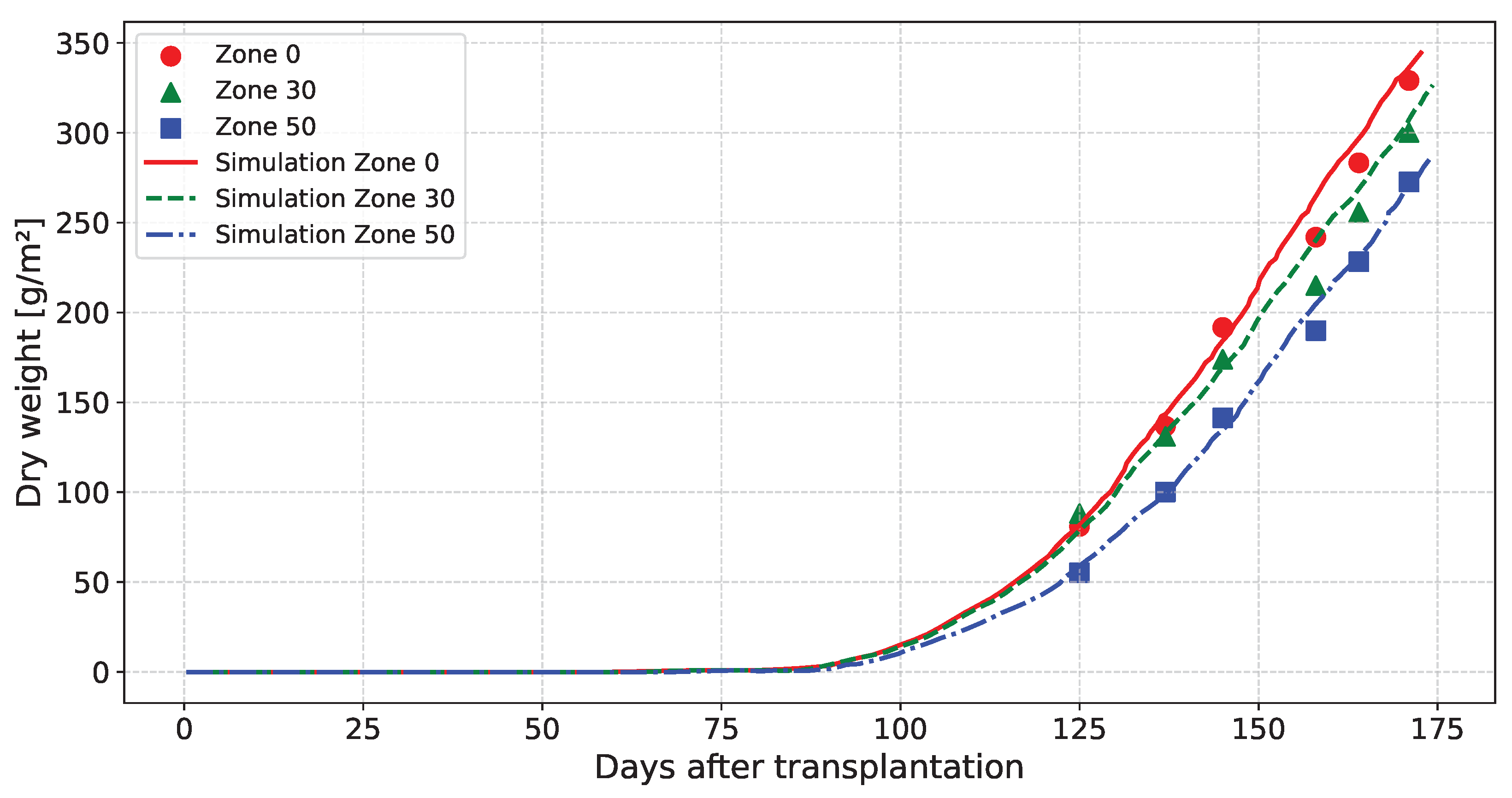1. Introduction
During the last few decades exponential growth in installed photovoltaic (PV) capacity has been observed worldwide. In order to reach the targets of the Paris Agreement and combat climate change, many countries are progressively increasing their share of renewable energies. Since large-scale PV systems have proven to be a green, cheap and reliable energy source, increasing PV energy production is a suitable approach for this task. The rapid growth of PV systems has thereby triggered direct land use changes and ground-mounted PV systems have been installed on arable land formerly used for food production [
1]. However, renewable energy does not threaten agricultural production; indeed, they can coexist in harmony as illustrated in the concept of agrivoltaics (APVs), describing the combination of agriculture and PV energy production on the same plot of land [
2]. APVs are a promising solution when it comes to meeting the growing demand for both food and energy while also addressing land use conflicts caused by expanding PV installations on farmland [
3].
One way to realize APV systems are PV greenhouses (GHs), where PV panels are installed on the roof or inside the GH [
4,
5]. In southern Spain, especially in the region of Almeria, over 30,000 ha of land are occupied by GHs [
6]. According to the European Commission’s PVGIS database, typical values of annual global horizontal irradiation in the Almeria region range between 1900 kW h m
−2 and 2100 kW h m
−2 per year [
7,
8]. These local environmental conditions make year-round crop production in GHs possible.
As photosynthesis is the key process in the production of biomass, sunlight is one of the most important environmental factors influencing plant growth and eventually yield in GHs [
9]. For photosynthesis, plants capture a fraction of the total radiation spectrum, the so-called photosynthetic active radiation (PAR) spectrum. The PAR spectrum includes wavelengths in the range of 400 nm to 700 nm and is quantified by the photosynthetic photon flux density (PPFD [μmol m
−2 s
−1]). For tomatoes, light not only fuels photosynthesis but also affects plant morphology, flowering, fruit set and ripening. Depending on the stage of plant development, tomatoes typically require 400 μmol m
−2 s
−1 to 700 μmol m
−2 s
−1 of PAR for efficient photosynthesis [
10]. Besides light intensity, the directional light distribution in the GH throughout the canopy also plays an important role [
11]. Several studies showed that plants use diffuse light, which leads to a more homogeneous light profile in the plant canopy, more efficiently than direct light [
12,
13,
14]. Furthermore, the photosynthetic rate of leaves shows a nonlinear response to the light flux density, converging towards a saturation point in which a further increase in PAR radiation does not translate into a higher value of photosynthetic rate [
15]. The light saturation point for tomato photosynthesis is around 700 μmol m
−2 s
−1 to 1000 μmol m
−2 s
−1, above which photosynthesis plateaus or decreases due to stress or photoinhibition. In addition, the exposure of tomatoes to intense light for long periods affects the accumulation of antioxidants in the fruits, like lycopene and Vitamin C, especially during the ripening stage, as these elements are sensitive to oxidation. It has been shown that excessive light may lead to oxidative degradation, while moderate shading can enhance or preserve these compounds in tomato fruit by reducing stress and photoinhibition [
16,
17].
As high light levels usually lead to photosynthetic saturation and a decrease in light use efficiency, farmers actively manage light and heat inside GHs [
6]. Typically, plastic covers for the GHs are used for this purpose [
6]; however, excessive sunlight requires farmers to further reduce the transmission of GH plastics throughout the crop cycles, often by applying white chalk paint [
18]. In addition, there are other techniques to reduce light transmission and manage the GH microclimate, such as the use of shading nets (applied internally or externally) [
19], thermal screens [
20], or even wavelength-selective plastic films, that block out a fraction of the infrared (IR) spectrum [
21,
22]. APV concepts offer another option to actively support this microclimate management of the growers. Shading techniques, both traditional shading nets or APV structures, can modify light intensity, spectrum and duration, affecting both yield and quality of the GH crops. To maintain successful GH cultivation, the balance between sufficient light for photosynthesis and avoiding stress-induced degradation is crucial. Traditional GH plastics, such as low-density polyethylene films, are often multi-layered with an ultraviolet (UV)-protection film toward the outside and agrochemical-resistant films toward the inside of the GH [
23]. Depending on their material composition, they mostly block out UV radiation and transmit important PAR. Traditional shading methods, such as shading nets or whitening agents, primarily reduce light intensity and slightly alter the spectrum by scattering more UV and blue light and blocking out a fraction of IR light. In contrast, traditional PV modules absorb a portion of PAR, especially in the blue and red regions, to generate electricity. As this may negatively affect the availability of PAR to the crops, more recent approaches for GH-implemented APV solutions focus on semi-transparent or spectrally selective PV technologies in order to allow more PAR transmission while still producing energy. It is therefore crucial to study the effect of shading caused by PV panels in APV GHs and the availability and distribution of PAR inside APV GHs.
In APV systems, irradiance could also be used to produce energy and the grower’s dependence on rising energy prices could be reduced [
24]. According to Dupraz et al. [
2], the productivity of APV GHs can increase up to 73% for crops benefiting from low-light conditions. A study by Hanrieder et al. demonstrated that a theoretical maximum PV coverage of approximately 44% in Almeria is feasible while ensuring that irradiance levels inside the GH remain above the typical irradiance thresholds necessary for healthy plant growth [
25].
Nevertheless, the integration of PV panels into the GH roof can create a significant reduction in solar radiation inside the GH with possible effects on microclimate and subsequently crop production [
26,
27,
28]. Several APV GH experiments and numerical simulations of APV GHs have been performed in recent years, and, depending on the local climate, these experiments reported different observations based on GH type and investigated crop. Marrou et al. observed that when mean daily air temperature and relative humidity (RH) in a GH were similar to full-sun conditions, the growth rate of some crops, such as lettuce and cucumber in summer, was not significantly different [
29]. Moreover, no reduction in lettuce yield was observed under a 50% and 70% reduction in incoming radiation in summer [
30]. Cossu et al. [
9] found that each 1% of roof coverage by PV modules reduces transmitted irradiance by approximately 0.8%. A checkerboard PV arrangement and a north–south orientation of the GH enhance light uniformity beneath the panels, potentially reducing shading stress on crops [
9]. López-Díaz et al. [
23] reported that shading levels above 30% delayed yield and reduced fruit quality in a Venlo GH in the Almeria region. The studies of Ezzari et al. [
31] and Sánchez et al. [
32] found that a 10% checkerboard PV cover did not significantly affect tomato yield in a Mediterranean GH. Beyond yield effects, shading can modify plant morphology, flowering time and fruit quality [
26]. In Mediterranean regions, where solar radiation typically satisfies crop requirements of high-light demanding crops, such as tomatoes, quality parameters such as Soluble Solids Content (SSC), color, firmness and pH remain largely unaffected by rooftop PV shading [
32,
33]. However, shading levels exceeding 40% have been shown to increase fruit firmness while reducing SSC in southeastern Spanish GH production systems [
19].
The results of the experimental studies show that there is no simple solution for a perfect APV GH and it is difficult to predict crop responses to artificial shading. In order to improve the understanding of APV systems and their influence on crop yield, modeling approaches are increasingly being employed in APV. Crop growth models enable simulating plant biomass accumulation, fruit yield and other physiological processes over time. However, for each application the model should be calibrated to local conditions, taking into account GH structure, climate variations and crop-specific physiological parameters. In the case of tomatoes, the Tomato Growth (TOMGRO) model of Jones et al. and its adaptations (e.g., the reduced TOMGRO model) have been widely validated for GH cultivation and tested under different environmental scenarios [
34]. Only recently have these modeling frameworks been applied in the context of APV systems, often focusing on the interplay between shading, temperature and solar irradiance on crop growth [
35,
36].
The present study addresses the research gap in experimental studies on APV GH with high shading ratios and provides a comprehensive analysis of partial shading using opaque dummy PV modules arranged in a checkerboard pattern on a raspa-y-amagado GH in Almeria. The objective of the study is to enhance the understanding of changes in plant development and impacts on crop yield in order to support the implementation of PV modules on GH. The radiation distribution, microclimate and the yield and quality of tomato plants in three different zones of the GH, with 50%, 30% and 0% (control) roof cover ratios, are experimentally evaluated. The experimentally measured data helps to improve our understanding of shading-related changes in tomato crops early on in the growing cycle. The study results can help to reduce shading-related yield reductions in future APV GH installations and motivate further research on APV GHs. Furthermore, the experimentally collected data was used to apply the reduced TOMGRO model under the specific shading conditions. The simulated dry weight of mature tomato fruits is compared with experimentally measured data. The application of the reduced TOMGRO model to APV GHs enables the simulation of detailed crop development and adaptations in physiological processes without the explicit need for experimental studies. The model can be used to simulate theoretical crop yield of future APV GHs and help further improve our understanding of crop responses to APV installations.
Section 2 describes the experimental setup, including the GH layout and the PV module pattern, as well as the data acquisition and measurement protocols. The modeling approach using the reduced TOMGRO model is presented in
Section 2.4.
Section 3 reports the measured and simulated results, and
Section 4 discusses the results in the context of different studies.
Section 5 summarizes the main conclusions and gives directions for future research.
4. Discussion
4.1. Experimental Results
The artificial shading in the presented experiment not only caused a radiation reduction but directly impacted the whole microclimate in the GH. Therefore, the development of the cultivated tomato plants was affected early on from the beginning of the crop cycle. Over the entire study period, there was an average reduction of 48% in radiation in the 50% shading zone, and a 25% reduction in the 30% shading zone in comparison to the control zone. These findings align well with the radiation reductions determined by Cossu et al. [
9], who indicated a radiation reduction of 0.8% for each additional 1.0% of PV shading.
The provided shading in the experiment resulted in 15% yield reduction for the 30% shading zone and 26% yield reduction for the 50% shading zone in measured fresh weight at the end of the crop cycle. These numbers align well with the findings of Callejón-Ferre et al. [
19] and Riga et al. [
49], who both reported a similar decrease in yield with an increase in shading ratio. Several other experimental studies also confirm that high shading levels lead to reduced tomato yield in GHs due to radiation reduction [
23,
53,
54,
55,
56,
57]. Nevertheless, it is important to point out that tomato yield is not an isolated characteristic and depends on the growth of the whole plant [
51]. If the tomato plant does not grow well then it will never give a high yield. Therefore yield is determined by the interaction between plant morphology, physiology and growth conditions.
In the presented experiment, the two shading zones and the control zone were not physically separated from one another. Hence, there was an exchange in air flow between the zones and no separation of temperature or RH within the different areas in the GH. Nevertheless, changes in temperature and RH were measured at the sensor locations at the center of the zones. The combination of changes in temperature and RH and reduction in irradiance directly affected the tomato plants at each stage of their development. In the presented experiment, differences in the development of the tomato plants were visible early in the growing stage, as the plant physiological measurements confirmed. These observations align well with the findings of Heuvelink et al. [
51], who showed that plant growth and productivity are directly correlated with the light intensity and environment temperature in the GH, which affect two important physiological processes: photosynthesis and respiration. Photosynthesis depends on both light intensity and temperature, while respiration only on temperature. Therefore, final yield and sugar content depend on the trend of these two physiological processes [
57].
In the presented experiment, plants from both shading zones developed on average 20% less fruits than the plants in the control zone throughout the entire crop cycle. Furthermore, a delay in ripening of the fruits was determined for both shading treatments, i.e., 6 days for 30% shading and 9 days for 50% shading after the first harvest in the control zone. Previous studies also showed that shading in GHs caused by PV panels reduces the number of produced fruits and causes a delay in ripening [
53,
58,
59]. A delay in ripening and a delayed tomato harvest can actually have strategic market advantages, especially if it shifts production into a period of lower supply and higher prices. García-Martínez et al. [
60] analyzed price trends in GH tomatoes across several Spanish regions and found that the highest seasonal price indices occurred in March and April. By strategically timing the delay in yield in an APV GH to coincide with periods of reduced supply and higher selling prices, growers can potentially compensate yield reductions resulting from the shading.
Apart from their influence on plant physiological development and yield, the effect of shading treatments on tomato quality, fruit size and dry matter content was also determined. At the end of the crop cycle a reduction in dry weight of 14% and 19% was observed for the 30% and 50% shading zones, respectively. In addition, for the fruits of the 50% shading zone, a reduction of 0.9 °Brix was measured at the end of the crop cycle. For the fruits of the 30% shading zone, a reduction of 0.2 °Brix was observed. SSC is an important quality parameter considering that the amount of sugar and acid and their interactions are related to flavor quality in tomatoes [
61]. According to Dorais et al. [
10], SSC is highly affected by the GH microclimate and environment including solar radiation, temperature, day-length, water availability, soil mineral content, irrigation and fertilization.
4.2. Theoretical PV Yield and Revenues
4.2.1. Electricity Self-Consumption and Feed-In
As APV concepts describe a trade-off between crop cultivation and energy production, it is important to emphasize the potential advantages of installing PV modules on GHs. One key benefit is that the electricity generated by the PV system can first be used to cover the GH’s own energy consumption and, secondly, to potentially overcompensate reductions in crop yield by selling surplus energy to the grid. This section provides an estimation of the potential economic benefits from self-consumption and energy sales, aimed at compensating crop yield reductions. The estimations are based on simplified assumptions and are not intended as a detailed economic analysis. Rather, they offer an initial indication of how APV systems can help to stabilize income and reduce dependence on fluctuating market prices.
For the economic evaluation, we consider three hypothetical scenarios for the entire GH: (1) no PV modules installed, (2) 30% of the roof covered with PV modules, and (3) 50% of the roof covered with PV modules. Crop and PV yield values are scaled to the 1765 m2 GH area for each of the three scenarios.
Based on the crop yield measurements of the 0% shading zone, the tomato yield scaled to the entire experimental GH under full-sun conditions without PV installation is 5820 kg. According to the measurements of the two shading zones, the applied shading treatments resulted in a 15% crop yield reduction for the 30% shading zone and 26% reduction for the 50% shading zone. This corresponds to approximately 895 kg less tomatoes for the 30% APV GH and 1504 kg less tomatoes for the 50% shading scenario. At a market price for tomatoes of 0.58 € kg
−1 for the 2023–2024 campaign [
62], the GH without PV would have lead to an income of EUR 3376 by solely selling the tomatoes. The reduction in crop yield in the two APV scenarios would have resulted in a loss of EUR 519 and EUR 872, respectively.
To estimate the PV yield of the two APV systems (30% and 50% roof coverage of the entire GH roof), the PVGIS SARAH radiation database was used [
8]. The breakdown of the monthly PV yield, as well as monthly prices for electricity are given in
Table A2 in
Appendix D. For the period from September to March, the estimated energy production was 57.26 MWh for the 30% shading scenario and 95.44 MWh for the 50% shading scenario, assuming standard silicon modules and default system losses. The total energy consumption of the experimental test GH during this period was approximately 2065 kWh. For the economic analysis, we assume the same energy consumption for all three scenarios. Based on average Spanish electricity prices from September 2023 to March 2024 [
63,
64], self-consumption of PV electricity to cover the GH’s energy demand during the tomato cycle could therefore save around EUR 165 in both APV scenarios. The levelized cost of electricity for the PV systems was estimated as 5.2 ctkWh
−1, based on the findings for rooftop PV from [
65] for the irradiation level of the site of this study. To calculate potential revenues from selling excess electricity, average feed-in tariffs during the study period [
66,
67] were considered. For the 30% shading scenario, the overall energy sales would therefore yield approximately EUR 832. For the 50% shading scenario, the selling of the excess PV energy would yield EUR 1407.
Table 8 summarizes the comparison of the calculated PV and crop yield revenues and estimates the overall profit increase for the two APV scenarios.
The hypothetical 30% shading system integrated into our 1765 m
2 GH generated an estimated 32.44 kWh m
−2 per crop cycle (September to March), which corresponds to a direct revenue of approximately 50 ct per m
2. For the hypothetical 50% shading system, the PV yield can be estimated with 54.07 kWh m
−2 for September to March, which corresponds to a revenue of 80 ct per m
2. In APV GH systems, the revenue generated from the PV installation can serve as a supplementary income and help offset operational costs of the GH such as electricity for climate control, irrigation or lighting. Over time, the APV GH dual-use approach can improve the economic viability and resilience of horticulture, particularly in regions with high solar irradiance [
68,
69].
In our two theoretical APV GH scenarios, both cases would overcompensate the reduction in crop yield and lead to a profit increase at the end of the crop cycle. For the 30% shading scenario, the additional income can be estimated as EUR 478, which corresponds to a profit increase of +14.8% with respect to the traditional GH without PV. The 50% cover ratio APV GH would have led to EUR 700 of additional income, which corresponds to an increase of +21.8%.
These results already demonstrate the economic potential of APV GH systems. Even during the winter months of the study period, when irradiance and PV output are naturally lower, a positive net income could be observed. During summer, PV yields are higher and radiation levels can even be harmful to crops. It can therefore be expected that the benefits of APV systems considering the full year are even greater, leading to a higher overall annual advantage.
4.2.2. Powering of Desalination Plants
The generated electricity of the PV system could be used to power desalination plants for water production, which could subsequently be used for GH irrigation [
70]. Such estimations become particularly important in years with low tomato market prices or under extreme climatic conditions. The desalination plant of Carboneras in the Almeria region, for example, has an energy requirement of 4.25 kW h per 1 m
3 produced freshwater [
71]. It should be noted that this value refers to one specific, exemplary plant and more modern and energy-efficient desalination technologies may require less energy. The PV yield of the 50% cover ratio system could lead to a production of 22,455 m
3 of desalinated water during the tomato cycle. The presented 30% cover ratio GH could supply up to 13,473 m
3 of freshwater during the same period.
The experimental GH required 271 m3 of water during the tomato cultivation period. The PV yield from the 50%-cover-ratio APV system could hence supply the experimental GH 82 times with freshwater. For the 30%-cover-ratio APV system, the water consumption would be covered 49 times. As mentioned in the previous subsection, PV yields are even higher in summer. The overall annual advantage can therefore be even higher considering the full year.
4.3. Discussion of Simulation with the Reduced TOMGRO Model
In addition to the presented experimental measurements, we also used the collected data to model crop growth and estimate yields with the reduced TOMGRO model. The modeling results presented in the previous chapter show a reasonable agreement with the experimentally measured dry weight data. The RMSE values remained below 12 g m
−2 for the two presented validation tests of the 30% shading zone and 0% control zone. At the end of the crop cycle, the model overestimated the experimentally measured values of the 30% shading zone by 4%. For the control zone, the model overestimated the experimentally measured values by 3% at the end of the crop cycle. In comparison to other studies that also used the TOMGRO model or its adaptions to simulate APV scenarios, the presented results point out the advantages of a detailed calibration and validation campaign of the model. The study of Ghaffarpour et al. [
35] integrated the reduced TOMGRO model into their APV GH; however, they validated their simulations against the experimental measurements of Hemming et al. [
72] and the simulation values from the work of Gong et al. [
73]. The modeling results of Ghaffarpour et al. underestimated both the experimental and the simulated values, with deviations of approximately 14% at the end of the crop cycle. Other studies on tomato yield in APV GHs neglect the calibration to site-dependent conditions and do not validate their application of the reduced TOMGRO model against experimental measurements [
36,
50]. Furthermore, these models assume optimal and stable temperature conditions and do not take into account the potential effect of shading on temperature inside the GH. The presented experiment showed that shading may alter the microclimate inside the GH such that the cultivated plants adapt to these conditions. Hence, the experimental measurement of these changes in microclimate is very important for future research. In addition, the yield simulations of crops under APV conditions would also be more accurate due to the correct mapping of the input microclimate data.
Nevertheless, it is important to mention possible limitations of the presented modeling approach and discuss potential improvements for future studies. First, the presented experiment covered the time period of one growing cycle. To utilize the data from one growing cycle to test the TOMGRO model, the data from the 50% shading zone was used for model calibration. Subsequently, the model was applied to the 30% and 0% shading zones. In order to fully generate an independent validation, the experimentally measured data of a second crop cycle would be necessary. In future studies, the model could also be tested against measurements from different GH types or sites.
In the presented study, the model was calibrated and tested using experimentally measured mature fruit dry weight data. The reduced TOMGRO model also simulates four other state variables, i.e., number of nodes, leaf area index, aboveground dry weight and fruit dry weight. These datasets were not recorded in the presented study as the main goal was to monitor experimentally the changes in microclimate and successively changes in plant physiology and yield of the tomato crops. In order to perform comprehensive model calibration and validation, additional datasets of these four parameters would be beneficial and could be monitored during a second growing cycle.
In addition to the available data, there are several other factors influencing the growth process of the tomato plants, which were considered in the current modeling approach. These include information about soil, irrigation and diseases or pests that is not directly included in the reduced TOMGRO model, as well as the assumption of a constant CO2 content in the GH. In general, soil properties, irrigation and fluctuations in CO2 concentration in the GH can play a non-negligible role in how plants develop and might not be mapped fully correctly in the presented modeling approach. Consequently, performing simulations with a new independent dataset could lead to diverging results as certain stress factors or growth conditions may not be correctly mapped right now. In future studies, a comprehensive measurement campaign could focus on monitoring such additional GH environment and tomato growth variables.
In general, the results show that a biophysical model-based approach with the reduced TOMGRO model can be used to perform yield estimations for tomatoes grown under APV conditions. In order to generate a fully independent and accurate validation, the data of another growing cycle would be needed. The model could also be applied to different types of crops, such as bell pepper or zucchini. Considering further calibration of the model parameters or an extension to cover different local environmental conditions, such as different climates or sites, could also be implemented.
4.4. Uncertainties and Limitations of the Study
Both the experimental measurements and the simulations of the presented study have sources of uncertainty that should be taken into account in the interpretation of the data.
First of all, the measurements of the sensors introduce a potential source of uncertainty to the microclimate measurements and subsequently the simulation with the reduced TOMGRO model. Sensor soiling, environmental influences or technical limitations might affect the accuracy of the input data of the model and thus influence the outputs. The sensors deployed in the experiment were calibrated in advance and constantly cleaned during the measurement period in order to minimize uncertainties due to soiling or tilting. Furthermore, daily quality control was performed with the measured microclimate data. In addition, PAR data, which is one of the input variables of the reduced TOMGRO model, was estimated by applying the linear regression model developed by Vindel et al. [
44] to the experimentally measured GHI data. Although deviations are minimal for validation locations, it should be kept in mind that the method may introduce additional uncertainties to the model, as the relationship between GHI and PAR is not always linear and can be influenced by local environmental conditions. Furthermore, the method of Vindel et al. [
44] has been developed for outside conditions. The irradiance spectrum within the GH can be different from the outside due to the transmission through the GH plastic, which introduces another source of uncertainty in the presented study. In a future measurement campaign, specifically chosen PAR radiation sensors, only monitoring the PAR spectrum, could be deployed in the GH to avoid the additional conversion step in the data evaluation.
In the presented experimental study all three zones were located within the same GH without any physical separation. Hence, a constant exchange of air flow between the zones was not actively prevented. In addition, all plants were irrigated equally and a potential change in water needs of the plants due to shading was not observed. Ideally, a separate GH would be needed for each shading treatment to ensure that the specific conditions of each zone are studied without interference from neighboring zones. Nevertheless, clear differences in the microclimate were observed with the presented experimental setup. These deviations were then also mapped realistically in the crop yield simulations of the three different zones.
4.5. Practical Applications
This work contributes to the development and refinement of APV systems for GHs by expanding the available experimental datasets. The experimental results improve our understanding of how PV modules installed on GH roofs influence the microclimate, crop development and expected yields under APV conditions. Future research could focus on optimizing PV module layouts to maintain light homogeneity inside the GH and minimize yield losses due to shading. Another promising direction is the development of smart shading strategies that dynamically adapt to the crop’s light requirements.
This study highlights the potential of APV GHs to serve as an additional and independent source of income for growers. The study included a preliminary economic analysis for the study period, which showed that reductions in crop yield may be overcompensated by the energy generated from PV modules. These benefits are likely to be even greater over the full year, particularly during summer months when solar irradiance is higher and GHs are not cultivated. In addition, the study incorporated tomato yield modeling using the reduced TOMGRO model. The results demonstrate that the model can be successfully adapted to APV conditions to simulate crop yield. The model can therefore be a valuable tool for estimating tomato yields in APV GHs without requiring extensive new experimental data.
5. Conclusions
The presented experiment investigated the impact of shading caused by PV modules on tomato crops in a commercial scale raspa-y-amagado GH. The experiment was conducted in the 2023–2024 growing season in Almeria, southern Spain. Two distinct shading zones with roof cover ratios of 50% and 30% were compared against a control zone without artificial shading. The experiment aimed to fill a research gap regarding experimental studies on APV GHs (type raspa-y-amagado) with high shading levels (above 30% roof cover ratio). The study contributes to a broader understanding of APV GHs and creates a baseline for future studies. The results of the presented study show that high shading levels lead to changes in microclimate, which then impact yield and fruit quality and cause a delay in harvest. The 30% and 50% shading zones resulted in 15% and 26% yield reductions, respectively, in measured fresh weight at the end of the crop cycle in comparison to the control zone. The study results showed that the 30% shading zone had a lower impact on fruit quality than the 50% shading zone with an increasing trend in SSC towards the end of the study. In contrast, 50% shading resulted in significant reductions in yield and quality of the fruits. The study showed that experimental data on these microclimate changes and impacts on yield is important to fully understand and also optimize APV scenarios.
Furthermore, the presented study included crop yield simulations using experimentally measured microclimate data. The simulation results highlighted the importance of using real-world climatic and radiation data to better understand crop responses to PV shading. The crop yield modeling was limited to the dataset of the presented study of one crop cycle, which introduced uncertainties to the presented results. Future studies could therefore include the validation of the yield simulations with a totally independent dataset from a different crop cycle. Additionally, adapting the model to other sites and crops can also be tested in the future.
A theoretical, preliminary evaluation of the expected PV yield and economic viability of the APV GH system was performed. The calculations were based on simplified assumptions, such as a constant selling price for the harvested crops and constant GH energy demand that is fully covered by PV energy and monthly average electricity prices. It should be kept in mind that this economic analysis is not a profound investigation of the specific case of the APV system, but rather aims to show the potential and benefits of APV GHs in general. As discussed previously, the revenues of the investigated PV systems are expected to compensate for the observed reductions in crop yield and indicate that APV GHs can create an additional source of income for growers, support self-sufficiency and improve independency from fluctuation market prices. Delayed harvests of crops in APV GHs can also present strategic market opportunities, as late-season tomato prices tend to rise when early supply declines. In order to achieve high prices for the APV crops, fruit quality should be comparable to the quality of unshaded crops.
The present study already showed the high potential of APV GHs in southern Spain. To minimize reductions in crop yield and create higher revenues, future studies could also include semitransparent PV modules or dynamic PV tracking systems.


